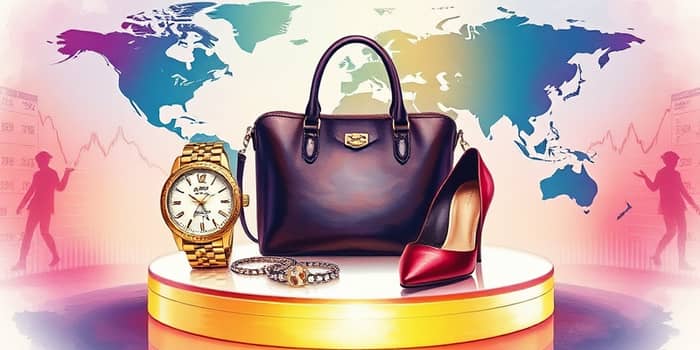
The allure of the luxury goods market transcends mere objects of desire, inviting wealth managers, brand strategists, and discerning investors to question its stability and long-term potential. As global economies wobble under inflationary pressures, geopolitical tensions, and shifting consumer sentiments, one wonders whether high-end fashion, exclusive timepieces, and limited-edition leather goods offer an unwavering fortress against downturns or mask unseen perils. In this exploration, we illuminate robust figures, regional dynamics, and evolving behaviors, guiding stakeholders through practical strategies, cautionary insights, and inspiring narratives designed to empower decision-making in this captivating yet complex sector.
According to recent data, the USD 327.52 billion in 2024 valuation marks a powerful milestone for high-end products worldwide, and affirms luxury’s enduring allure. Industry analysts forecast a rise to USD 349.15 billion in 2025, accelerating to USD 480.54 billion by 2033 at a CAGR of 6.6% (2025–2033). After the pandemic-induced contraction to USD 259.14 billion in 2020, the sector rebounded vigorously, thanks to pent-up demand, expanding digital channels, and resilient high-net-worth spending. The robust recovery in 2021–2022 laid a foundation for sustained year-on-year growth, driven by innovation in online retail and experiential marketing. For investors, these figures reveal a market that combines solid fundamentals with aspirational narratives, although understanding the nuances behind headline numbers remains critical for strategic allocation and risk management.
Growth is unevenly distributed, with certain geographies and product categories generating outsized contributions. The intersection of demographic shifts, travel patterns, and cultural tastes creates unique pockets of opportunity that demand localized approaches. By analyzing detailed consumption metrics, stakeholders can tailor brand positioning, retail footprints, and product launches to maximize both short-term performance and long-term equity.
Within product segments, the bedrock of growth lies in luxury fashion and leather goods. Fashion brands leverage seasonal collections and heritage couture to maintain momentum, with the segment expected to reach USD 115.9 billion by 2025 on the back of prêt-à-porter, bespoke collaborations, and limited-run capsule lines. Meanwhile, luxury leather goods—spanning iconic handbags, artisanal belts, and bespoke accessories—are forecasted at USD 79.36 billion, underpinned by strong brand loyalty and high margins. Recognizing these categories as cornerstone opportunities allows investors and brand managers to refine portfolios, optimize supply chains, and amplify marketing narratives that resonate with elite clientele.
The essence of luxury is defined by exclusivity craftsmanship heritage limited quantities. At its core, the sector thrives on a delicate balance between scarcity and desirability, often weaving narratives that celebrate artisanal legacies and meticulous handcrafting techniques. Consumers are drawn not only to the end product but to the story of master craftsmen, rare materials, and generational expertise. This deep emotional engagement fosters brand loyalty that can span lifetimes and transcend product cycles.
Beyond objects, luxury experiences—such as private trunk shows, personalization services, and curated cultural events—forge intimate connections with clients. These experiences engender trust, reinforce prestige, and create pathways for higher-value purchases. For ultra-wealthy collectors, the intangible allure of exclusivity often eclipses price sensitivity, reflecting a value system that places emotional and social capital above pure utility.
Historical patterns demonstrate that luxury goods frequently outperform mainstream consumer markets during recessions. Unlike mass-market segments, which rely on broad swathes of income-sensitive consumers, the luxury sector draws strength from individuals whose wealth cushions them from fleeting market gyrations. During the 2021–2022 economic softening, leading houses such as LVMH, Hermès, and Rolex sustained—and in some cases grew—their revenue streams while most retail categories contracted.
The phenomenon of revenge spending during downturns fuels demand, especially in the aftermath of restrictive periods. Affluent consumers often view luxury acquisitions as both a personal reward and a symbolic reclaiming of normalcy. This psychological driver, complemented by resilient capital reserves and agile distribution networks, fortifies the sector against short-term turbulence.
Nevertheless, no industry is entirely immune to systemic shocks. The precipitous drop in 2020—when the market contracted from USD 305.46 billion to USD 259.14 billion—highlighted vulnerabilities exposed by global lockdowns, disrupted supply chains, and plummeting tourism. Luxury brands heavily reliant on physical retail in travel hubs faced acute pressure, underscoring the need for omnichannel resilience.
Prolonged economic stagnation, escalating trade disputes, or regulatory interventions such as increased luxury taxes could curtail discretionary spending and erode profit margins. The rise of second-hand luxury platforms and rental services also introduces new competition, while counterfeit goods and online fraud pose reputational and financial threats. Vigilant risk management and agile contingency planning remain indispensable.
To sustain growth and relevance, luxury houses are embracing innovation and agility. The digital revolution transcends mere ecommerce, encompassing advanced data analytics, virtual and augmented reality showrooms, and personalized AI-driven recommendations that replicate in-store experiences online. Sustainability, too, has become a strategic imperative, with brands investing in traceable supply chains, recycled materials, and carbon-neutral operations to align with evolving consumer ethics.
Moreover, integration of blockchain for product authentication and investment in expert craftsmanship training programs safeguards both heritage and authenticity in a rapidly evolving landscape.
As wealth distribution shifts and new generations ascend to affluence, the luxury market will evolve in form and function. Brands attuned to microtrends such as the demand for gender-fluid designs, personalized customization, and experiential luxury will distinguish themselves. Additionally, monitoring global macroeconomic indicators and fiscal policy trends can pre-emptively signal shifts in high-net-worth spending patterns.
For investors and executives, practical steps include strategic portfolio diversification across geographies and segments, rigorous scenario planning for stress events, and continuous digital innovation to capture younger demographics. Engaging deeply with clients through loyalty programs, bespoke experiences, and transparent sustainability measures strengthens resilience and fosters brand advocacy. By marrying timeless craftsmanship with forward-thinking strategies, stakeholders can navigate uncertainties, harness growth opportunities, and chart a course toward lasting success.
Ultimately, the luxury goods market represents a dynamic intersection of art, culture, and commerce, offering both formidable resilience and inherent risks. Stakeholders who approach this sector with a blend of reverence for its heritage and a vigilant eye on emerging trends will find a landscape ripe with opportunity. In a world where perception is as valuable as possession, mastering the balance between exclusivity and adaptability will determine whether luxury remains a steadfast bastion in turbulent times or falters under shifting tides.
References













